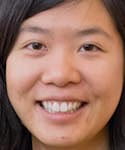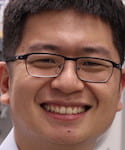A computational biologist and a bioengineer will join Rice’s Brown School of Engineering faculty as the latest recruits through the Cancer Prevention and Research Institute of Texas (CPRIT).
With the help of $3.6 million in CPRIT funding, Vicky Yao, who was a postdoctoral fellow at the Lewis-Sigler Institute for Integrative Genomics at Princeton University, joined Rice as an assistant professor of computer science this semester, and Jiaozhi (George) Lu, an NIH Pathway to Independence postdoctoral fellow at the California Institute of Technology (Caltech), will follow as an assistant professor of bioengineering in January.
Yao, who earned a Ph.D. in computer science at Princeton, specializes in developing machine learning and statistical methods to better understand biological circuitry and how its dysregulation can cause diseases. Her projects have included building cell-type-specific functional networks for human neurons relevant to Alzheimer’s, a system to predict tissue-gene expression patterns in worms, and a crowdsourcing game to annotate biological pathways.
“There are some high-level themes in my research that carry over for the CPRIT grant,” Yao said. “I want to take advantage of the huge amount of data available to parse and understand the what’s going wrong when cells grow uncontrollably.”
She said computer modeling has the power to expand knowledge about biological systems and prioritize what to study in model organisms. “Now that we have so much data from humans and different model organisms, we can develop computational methods to mine and prioritize areas that are relevant between the two,” she said. “Model organisms clearly capture something about human biology, but they’re also clearly not human.
“The question is, if we’re going to experiment with them, how do we prioritize areas that are more likely to be truthful and relevant for human disease?” Yao said.
She said her work on cell- and tissue- specificity will feed directly into her cancer research. “It’s clear certain cells are more vulnerable, and in cancers there’s also a lot of cell and tissue specificity,” Yao said. “Some mutations may affect certain cell types more than others, and we want to take advantage of the data available to understand what’s going on.”
Yao said her new colleagues at Rice’s computer science department made a great impression. “The department and the people there, the fact that they’re solid in research and small but diverse, was a huge selling point,” she said. “The collegial and supportive environment was a huge draw and felt very welcoming.”
Lu, who earned his Ph.D. at the University of California, San Diego, before moving to Caltech, genetically engineers proteins and cells for molecular imaging and cell therapies. He was recognized as the Young Investigator of the Year by the World Molecular Imaging Society in 2018 for pioneering work that uses ultrasound technology to enhance MRI.
That work involved the development of genetically encodable, gas-filled protein nanostructures that serve as MRI contrast agents but can be turned off with a pulse of ultrasound. Because contrast agents are often indistinguishable from the MRI contrast of the tissues being imaged, the ability to effectively erase the agents allows them to be seen without ambiguity.
Unlike light-triggered agents, sound waves and magnetic fields pass harmlessly through biological tissues. Lu said that gives the method potential for noninvasive imaging in clinics.
“You can imagine them as a cluster of nanoscale bubbles inside cells,” he said. “When an ultrasound pulse is applied, the air will be squeezed out and get dissolved into the surrounding water. Since the imaging contrast depends on the air, the ultrasound pulse eliminates the contrast.”
In nature, the proteins are found in water-borne photosynthetic microbes that use them like ballast tanks in a submarine. “These microbes want to float to the top to compete for the maximum amount of sunshine in water or a lake,” Lu said. “They evolved these gas nanostructures in order to do that.”
At Rice, he wants to turn monocolor MRI and ultrasound images of these protein nanostructures into multicolor ones. “We have clues how to differentiate the various ‘colors’ of these nanostructures based on their physical strength under ultrasound,” he said. “Now the question is why they possess different strengths and how we can design the gene sequence to encode such properties.
“Another focus of the lab will be to revisit some basic biology questions, to know how these gas proteins are made,” he said. “We don’t, for example, have a high-resolution structure for these nanostructures, and determining that will help us design new functions.”
The grants are part of 71 for nearly $136 million CPRIT awarded in the current round, with a focus in this round on advancing pediatric cancer research. CPRIT was approved by state taxpayers in a 2007 ballot initiative, providing $3 billion to support cancer research statewide. To date, the agency has awarded $2.4 billion in grants to Texas researchers, institutions and organizations through its academic research, prevention and product development research programs.



